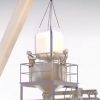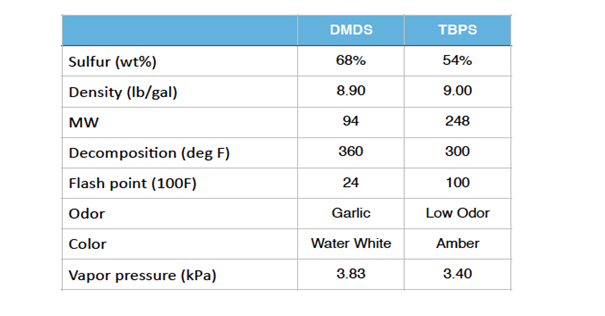RL Blogs

By Reactor Resources
Nov 27, 2017An introduction to sulfiding of hydrotreating catalysts. |
| To reduce the air pollutants SOx and NOx that are formed by internal combustion engines, most countries strictly limit the sulfur and nitrogen content of motor fuels. The primary process refineries use for removing these contaminants from gasoline, diesel, and jet fuel is referred to as hydrotreating or hydroprocessing.
The hydrotreating process involves mixing hydrogen with sour hydrocarbon feed inside a reactor filled with Cobalt/Molybdenum (CoMo) or Nickel/Molybdenum (NiMo) catalysts. In their active form, CoMo and NiMo catalyze the reactions that convert sulfur and nitrogen contaminants into H2S and NH3.
Catalyst Basics
Hydrotreating catalysts are produced by coating alumina extrudates with potentially active metals such as cobalt, nickel, molybdenum, and tungsten. In the catalyst production process, these metals are deposited on the alumina substrate in their benign oxide form and must be converted to the corresponding sulfide before they will catalyze hydrodesulfurization (HDS) and hydrodenitrification (HDN) reactions.
After a hydrotreater or hydrocracker reactor is loaded with fresh catalyst, the activation step, referred to as “sulfiding”, is accomplished by reacting the metal oxides with hydrogen sulfide (H2S) in the presence of hydrogen. This process is often referred to as “presulfiding” since the sulfiding process is carried out prior to resuming operation of the hydrotreating unit.
Catalyst sulfiding involves the following chemical reactions:
The Sulfiding Process
The sulfiding process involves passing feed spiked with a sulfiding agent over the catalyst bed in a carefully controlled procedure that includes several temperature holds. As the feed and spiking agent are heated in the presence of hydrogen, the sulfur compound will readily decompose to form the H2S required to complete the sulfiding reactions.
Sulfiding Agents
The sulfiding agents most commonly used by refiners today are dimethyl sulfide (DMDS) and tertiary-butyl polysulfide (TBPS). DMDS is used in the majority of sulfiding applications due to its higher sulfur content (68% vs. 54%) and lower cost. It also decomposes in two steps, reducing the chance of reactor exotherms that can result from sulfiding reactions. TBPS is used in some cases where a lower decomposition temperature is desirable. The table below compares the two most commonly used sulfiding agents.
Each catalyst manufacturer has their own procedure for achieving maximum performance from their catalysts, but in general they all follow a process similar to the profile shown below. This illustration represents a sulfiding regimen with DMDS as the sulfiding agent.
Temperature Profile for Sulfiding Hydrotreating Catalysts
The initial phase involves a drying step to remove any water that may remain in the system from cleaning during the turnaround, as well as moisture entrained within the catalyst pores. Hydrotreating catalysts are hydroscopic and can easily absorb 2-4% water when exposed to humid air during the loading process.
If the catalyst bed is heated too quickly while moisture remains in the catalyst pores, steam will rapidly form that can cause physical damage to the catalyst particles. This phenomenon is commonly referred to as the “popcorn effect”, since rapid steam formation can fracture the catalyst similar to the way popcorn is formed by heating.
Catalyst Wetting
After the bed is thoroughly dried (typically 2-4 hours in the range of 200-250F), the “wetting step” can begin. This may seem counter-intuitive since the catalyst was just dried in the previous step, but in this case we are referring to wetting the catalyst with warm hydrocarbon feed.
A heat wave will normally be seen during the wetting step that results from the heat of absorption released when hydrocarbon wicks into the pores of the extremely dry catalyst. Wetting ensures that all of the catalyst particles are evenly coated with hydrocarbon, leading to improved distribution once the sulfiding step begins.
Once wetting is complete, the temperature of the reactor can be ramped up to the level at which the sulfiding agent will be injected. This temperature range varies from 360-420F depending on the catalyst manufacturer, the type of catalyst, and the reactor pressure.
Sulfide Injection
After injection begins, catalyst bed temperatures must be monitored closely since DMDS decomposition and the sulfiding reaction are both exothermic. A typical guideline will limit the delta T across each catalyst bed to 50F. Again, this will vary depending on the size and type of unit being sulfided and the mass flux through the bed.
The H2S level of the gas effluent from the reactor also needs to be closely monitored once injection begins. This is normally handled by sampling the gas stream from open sample ports with draeger tubes or an online H2S analyzer.
H2S Breakthrough
The reactor temperature is normally held below 450F for 10-12 hours until H2S “breakthrough” occurs. This step is often referred to as the “first sulfiding plateau”. Breakthrough is determined when the H2S concentration of the gas exiting the reactor reaches 3000-5000 ppm. Prior to breakthrough, very little H2S will be seen in the gas effluent since the oxide catalyst is reacting with and consuming all of the sulfur injected into the feed.
Breakthrough is a signal that the catalyst particles in the reactor are saturated with sulfur and indicates that the reactor temperature can be raised without harming the oxide catalyst. If bed temperatures are raised prematurely (> 450F), reduction of the metal oxides will occur, preventing formation of the active sulfide form of the catalytic metals.
It should be noted that water is a by-product of the sulfiding reaction and its formation signifies that the active sulfide form of the catalyst is being produced. The amount of byproduct water produced will be approximately 8-10 wt% of the catalyst weight. In addition, ~2 SCF of hydrogen will be consumed per pound of catalyst loaded in the reactor.
Once the catalyst bed reaches 600-660F (the final hold temperature varies with catalyst manufacturer), the second sulfiding plateau can begin. This phase will normally last for 4-8 hours. During the second temperature hold, sulfiding reaction kinetics will initially accelerate, leading to an increased consumption of H2S in the recycle gas. To compensate, the injection rate of the sulfiding agent is increased while the H2S content is closely monitored.
Completion of the sulfiding process is normally indicated by the H2S content of the recycle gas quickly rising to levels exceeding 20,000 ppm (2.0%). Once the calculated amount of sulfur being injected to the unit equals the amount of sulfur exiting the reactor, sulfiding is complete and chemical injection should cease.
Proper sulfiding of hydrotreating catalysts is critical for obtaining optimum HDS and HDN activity from a hydroprocessing unit. The sulfiding process must be carefully monitored to avoid reduction of the metal oxides prior to the formation of the active sulfides and to ensure that the active metal sites are properly and completely formed.
Having adequate information, such as sulfiding agent injection rates and the H2S content of the reactor gas effluent, allows precise control of the sulfiding process and avoids problems caused by excessively sour gas overloading the recycle compressor.
For more information on the optimum procedure and techniques for sulfiding, contact the pros at Reactor Resources. |
|
|



.png)







